5.2 Sleep and Dreaming: Good Night, Mind
Why are dreams considered an altered state of consciousness?
Sleep can produce a state of unconsciousness in which the mind and brain apparently turn off the functions that create experience: The theater in your mind is closed. But this is an oversimplification because the theater actually seems to reopen during the night for special shows of bizarre cult films—
altered state of consciousness
A form of experience that departs significantly from the normal subjective experience of the world and the mind.
Sleep
Consider a typical night. As you begin to fall asleep, the busy, task-
147

Sleep Cycle
The sequence of events that occurs during a night of sleep is part of one of the major rhythms of human life, the cycle of sleep and waking. This circadian rhythm is a naturally occurring 24-
circadian rhythm
A naturally occurring 24-
The sleep cycle is far more than a simple on–
The largest changes in EEG occur during sleep. These changes show a regular pattern over the course of the night corresponding to five sleep stages (see FIGURE 5.7). In the first stage of sleep, the EEG moves to frequency patterns even lower than alpha waves (theta waves). In the second stage of sleep, these patterns are interrupted by short bursts of activity called sleep spindles and K complexes, and the sleeper becomes somewhat more difficult to awaken. The deepest stages of sleep are stages 3 and 4, known as slow-

What do EEG recordings tell us about sleep?

During the fifth sleep stage, REM sleep, a stage of sleep characterized by rapid eye movements and a high level of brain activity, EEG patterns become high-
REM sleep
A stage of sleep characterized by rapid eye movements and a high level of brain activity.
What are the stages in a typical night’s sleep?
148
Putting EEG and REM data together produces a picture of how a typical night’s sleep progresses through cycles of sleep stages (see FIGURE 5.8). In the first hour of the night, you fall all the way from waking to the fourth and deepest stage of sleep, the stage marked by delta waves. These slow waves indicate a general synchronization of neural firing: the neuronal equivalent of “the wave” moving through the crowd at a stadium as lots of individuals move together in synchrony. You then return to lighter sleep stages, eventually reaching REM and dreamland. Note that although REM sleep is lighter than that of lower stages, it is deep enough that you may be difficult to awaken. You then continue to cycle between REM and slow-
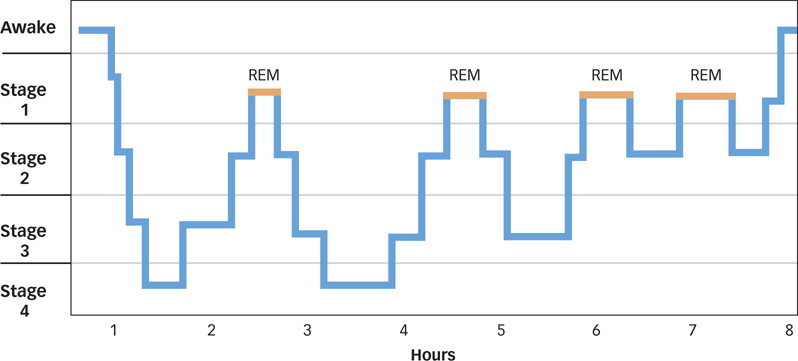
Sleep Needs and Deprivation
How much do people sleep? The answer depends on the age of the sleeper (Dement, 1999). Newborns will sleep 6 to 8 times in 24 hours, often totaling more than 16 hours. Their napping cycle gets consolidated into “sleeping through the night,” usually sometime between 9 and 18 months. The typical 6-
149
This is a lot of sleeping. Could we tolerate less? For a 1965 science project, 17-
DATA VISUALIZATION
Consciousness
Feats like this one suggest that sleep might be expendable. This is the theory behind the classic all-
What is the relationship between sleep and learning?
Sleep turns out to be a necessity rather than a luxury in other ways as well. At the extreme, sleep loss can be fatal. When rats are forced to break Randy Gardner’s human waking record and stay awake even longer, they have trouble regulating their body temperature and lose weight although they eat much more than normal. Their bodily systems break down and they die, on average, in 21 days (Rechtshaffen et al., 1983). Even for healthy young humans, a few hours of sleep deprivation each night can have a cumulative detrimental effect: reducing mental acuity and reaction time, increasing irritability and depression, and increasing the risk of accidents and injury (Coren, 1997).
Some studies have deprived people of different sleep stages selectively by waking them whenever certain stages are detected. Memory problems and excessive aggression are observed in both humans and rats after only a few days of being wakened whenever REM activity starts (Ellman et al., 1991). Such REM deprivation causes a rebound of more REM sleep the next night (Brunner et al., 1990). Deprivation from slow-
It’s clearly dangerous to neglect the need for sleep. But why would we have such a need in the first place? All animals appear to sleep, although the amount of sleep required varies quite a bit from species to species (see FIGURE 5.9). Giraffes sleep less than 2 hours daily, whereas brown bats snooze for almost 20 hours. These variations in sleep needs—
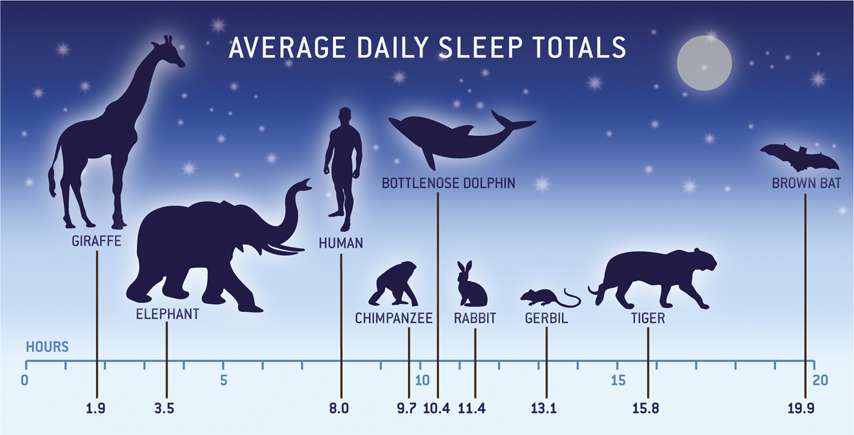
150

Sleep Disorders
In answer to the question, “Did you sleep well?,” comedian Stephen Wright said, “No, I made a couple of mistakes.” Sleeping well is something everyone would love to do, but for many people, sleep disorders are deeply troubling.
Insomnia, difficulty in falling asleep or staying asleep, is perhaps the most common sleep disorder. About 30-
insomnia
Difficulty in falling asleep or staying asleep.
What are some problems caused by sleeping pills?
151
Sleep apnea is a disorder in which the person stops breathing for brief periods while asleep. A person with apnea usually snores because apnea involves an involuntary obstruction of the breathing passage. When episodes of apnea occur for over 10 seconds at a time and recur many times during the night, they may cause many awakenings and sleep loss or insomnia. Apnea occurs most often in middle-
sleep apnea
A disorder in which the person stops breathing for brief periods while asleep.
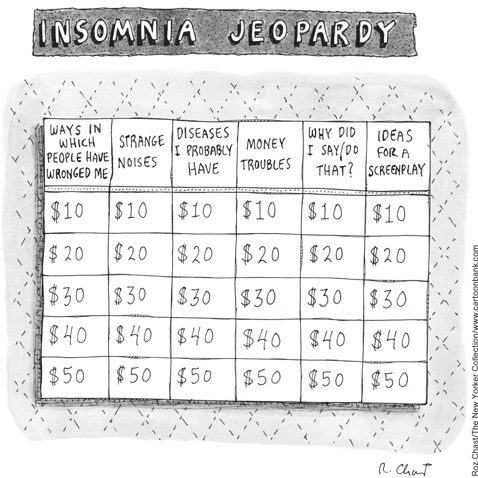
Somnambulism (or sleepwalking) occurs when a person arises and walks around while asleep. Sleepwalking is more common in children, peaking between the ages of 4 and 8 years, with 15-
somnambulism (or sleepwalking)
Occurs when a person arises and walks around while asleep.
Is it safe to wake a sleepwalker?
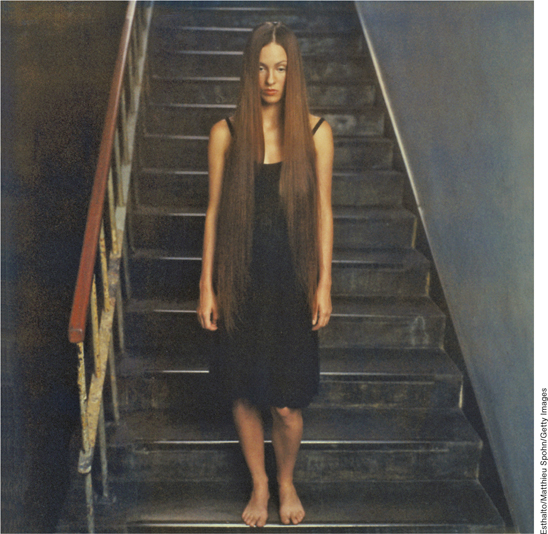
There are other sleep disorders that are less common. Narcolepsy is a disorder in which sudden sleep attacks occur in the middle of waking activities. Narcolepsy involves the intrusion of a dreaming state of sleep into waking and is often accompanied by unrelenting excessive sleepiness and uncontrollable sleep attacks lasting from 30 seconds to 30 minutes. This disorder appears to have a genetic basis, as it runs in families, and it can be treated effectively with medication. Sleep paralysis is the experience of waking up unable to move and is sometimes associated with narcolepsy. This eerie experience usually happens as you are awakening from REM sleep but before you have regained motor control. This period typically lasts only a few seconds or minutes and can be accompanied by hypnopompic (when awakening) or hypnagogic (when falling asleep) hallucinations in which dream content may appear to occur in the waking world. A very clever series of recent studies suggests that sleep paralysis accompanied by hypnopompic hallucinations of figures in one’s bedroom seems to explain many perceived instances of alien abductions and recovered memories of sexual abuse (aided by therapists who used hypnosis to help the sleepers [incorrectly] piece it all together; McNally & Clancy, 2005). Night terrors (or sleep terrors) are abrupt awakenings with panic and intense emotional arousal. These terrors, which occur most often in children and in only about 2% of adults (Ohayon, Guilleminault, & Priest, 1999), happen most often in non-
narcolepsy
A disorder in which sudden sleep attacks occur in the middle of waking activities.
sleep paralysis
The experience of waking up unable to move.
night terrors (or sleep terrors)
Abrupt awakenings with panic and intense emotional arousal.
152
To sum up, there is a lot going on when we close our eyes for the night. Humans follow a pretty regular sleep cycle, going through the five stages of sleep during the night. Disruptions to that cycle, either from sleep deprivation or sleep disorders, can produce consequences for waking consciousness. But something else happens during a night’s sleep that affects our consciousness, both while asleep and when we wake up.
Dreams
Pioneering sleep researcher William C. Dement (1959) said, “Dreaming permits each and every one of us to be quietly and safely insane every night of our lives.” Indeed, dreams do seem to have a touch of insanity about them. Even more bizarre is the fact that we are the writers, producers, and directors of the crazy things we experience in dreams. Just what are these experiences, and how can they be explained?
Dream Consciousness
Dreams depart dramatically from reality. You may dream of being naked in public, of falling from a great height, of sleeping through an important appointment, or of being chased (Holloway, 2001). These things don’t happen much in reality unless you’re having a very bad life. The quality of consciousness in dreaming is also altered significantly from waking consciousness. There are five major characteristics of dream consciousness that distinguish it from the waking state (Hobson, 1988).
- We intensely feel emotion, whether it is bliss or terror or love or awe.
- Dream thought is illogical: The continuities of time, place, and person don’t apply. You may find you are in one place and then another, for example, without any travel in between—
or people may change identity from one dream scene to the next. - Sensation is fully formed and meaningful; visual sensation is predominant, and you may also deeply experience sound, touch, and movement (although pain is very uncommon).
- Dreaming occurs with uncritical acceptance, as perfectly normal rather than bizarre.
- We have difficulty remembering the dream after it is over. People often remember dreams only if they are awakened during the dream and even then may lose recall for the dream within just a few minutes of waking. If waking memory were this bad, you’d be standing around half-
naked in the street much of the time, having forgotten your destination, clothes, and lunch money.
What distinguishes dream consciousness from the waking state?

Not all of our dreams are fantastic and surreal, however. We often dream about mundane topics that reflect prior waking experiences or “day residue.” Current conscious concerns pop up (Nikles et al., 1998), along with images from the recent past. The day residue does not usually include episodic memories—
153
Some of the most memorable dreams are nightmares. One set of daily dream logs from college undergraduates suggested that the average student has about 24 nightmares per year (Wood & Bootzin, 1990), although some people may have them as often as every night. Children have more nightmares than adults, and people who have experienced traumatic events are inclined to have nightmares that relive those events. Following the 1989 earthquake in the San Francisco Bay area, for example, college students who had experienced the quake reported more nightmares than those who had not, and they often reported that the dreams were about the quake (Wood et al., 1992).

Dream Theories
Dreams are puzzles that cry out to be solved. The search for dream meaning goes all the way back to biblical figures, who interpreted dreams and looked for prophecies in them. In the Old Testament, the prophet Daniel (a favorite of three of the authors of this book) curried favor with King Nebuchadnezzar of Babylon by interpreting the king’s dream. Unfortunately, the meaning of dreams is usually far from obvious.
In the first psychological theory of dreams, Freud (1900/1965) proposed that dreams are confusing and obscure because the dynamic unconscious creates them precisely to be confusing and obscure. According to Freud’s theory, dreams represent wishes, and some of these wishes are so unacceptable, taboo, and anxiety producing that the mind can only express them in disguised form. For example, a dream about a tree burning down in the park across the street from where a friend once lived might represent a camouflaged wish for the death of the friend. In this case, wishing for the death of a friend is unacceptable, so it is disguised as a tree on fire. The problem with Freud’s approach is that there is an infinite number of potential interpretations of any dream, and finding the correct one is a matter of guesswork—
Although dreams may not represent elaborately hidden wishes, there is evidence that they do feature the return of suppressed thoughts. Researchers asked volunteers to think of a personal acquaintance and then to spend 5 minutes before going to bed writing down whatever came to mind (Wegner, Wenzlaff, & Kozak, 2004). Some participants were asked to suppress thoughts of this person as they wrote, others were asked to focus on thoughts of the person, and yet others were asked just to write freely about anything. The next morning, participants wrote dream reports. Overall, all participants mentioned dreaming more about the person they had named than about other people. But they most often dreamed of the person they named if they were in the group that had been assigned to suppress thoughts of the person the night before. This finding suggests that Freud was right to suspect that dreams harbor unwanted thoughts. Perhaps this is why actors dream of forgetting their lines, travelers dream of getting lost, and football players dream of fumbling the ball.
Another key theory of dreaming is the activation-synthesis model (Hobson & McCarley, 1977). This theory proposes that dreams are produced when the brain attempts to make sense of random neural activity that occurs during sleep. During waking consciousness, the mind is devoted to interpreting lots of information that arrives through the senses. You figure out that the odd noise you’re hearing during class is your cell phone vibrating, for example, or you realize that the strange smell in the hall outside your room must be from burned popcorn. In the dream state, the mind doesn’t have access to external sensations, but it keeps on doing what it usually does: interpreting information. Because that information now comes from neural activations that occur without the continuity provided by the perception of reality, the brain’s interpretive mechanisms can run free. This might be why, for example, a person in a dream can sometimes change into someone else. There is no actual person being perceived to help the mind keep a stable view. In the mind’s effort to perceive and give meaning to brain activation, the person you view in a dream about a grocery store might seem to be a clerk but then change to be your favorite teacher when the dream scene moves to your school. The great interest people have in interpreting their dreams the next morning may be an extension of the interpretive activity they’ve been doing all night.
activation–synthesis model
The theory that dreams are produced when the brain attempts to make sense of random neural activity that occurs during sleep.
What is the evidence that we dream about our suppressed thoughts?
154
The Freudian theory and the activation–

The Dreaming Brain
What happens in the brain when we dream? Several fMRI studies show that the brain changes that occur during REM sleep correspond clearly with certain alterations of consciousness that occur in dreaming. FIGURE 5.10 shows some of the patterns of activation and deactivation found in the dreaming brain (Nir & Tononi, 2010; Schwartz & Maquet, 2002). Many dreams have emotional content—
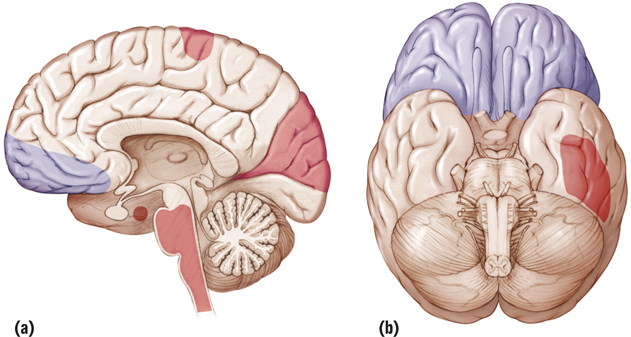
What do fMRIs tell us about why dreams don’t have coherent story lines?
155
Another odd fact of dreaming is that while the eyes are moving rapidly, the body is otherwise very still. During REM sleep, the motor cortex is activated, but spinal neurons running through the brain stem inhibit the expression of this motor activation (Lai & Siegal, 1999). This turns out to be a useful property of brain activation in dreaming; otherwise, you might get up and act out every dream! People who are moving during sleep are probably not dreaming. The brain specifically inhibits movement during dreams, perhaps to keep us from hurting ourselves.
SUMMARY QUIZ [5.2]
Question 5.4
| 1. | The cycle of sleep and waking is one of the major patterns of human life called |
- the circadian rhythm.
- the sleep stages.
- the altered state of consciousness.
- subliminal perception.
a.
Question 5.5
| 2. | Sleep needs _____________ over the life span. |
- decrease
- increase
- fluctuate
- remain the same
a.
Question 5.6
| 3. | Which explanation of dreams proposes that they are produced when the mind attempts to make sense of random neural activity that occurs in the brain during sleep? |
- Freud’s psychoanalytic theory
- the activation–
synthesis model - the cognitive unconscious model
- the manifest content framework
b.
Question 5.7
| 4. | fMRI studies of the dreaming brain reveal all of the following EXCEPT |
- increased sensitivity to emotions.
- activations associated with visual activity.
- increased capacity for planning.
- prevention of movement.
c.